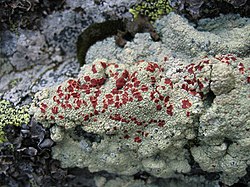Description
Members of the family Ophioparmaceae are crustose or squamulose lichens, forming either thin, crust-like patches or collections of small, scale-like squamules . They do not produce isidia (tiny bud-like outgrowths), and soralia—the powdery patches of reproductive granules —are either absent or arise along the edges of the squamules. The photosynthetic partner is a green alga of the chlorococcoid type, meaning simple spherical cells of the genus Trebouxia and its allies. [3]
The fruiting bodies are disc-like apothecia that sit directly on the thallus surface, usually red to black in colour and sometimes covered with a pale dusting ( pruina ). These discs are flat and may have a slightly wavy margin; the thalline margin , formed from thallus tissue, can be present or absent depending on the species. The apothecial wall ( true exciple ) is typically raised and persistent, though in some cases it becomes excluded as the apothecium ages. Internally, the spore-bearing tissue (hymenium) turns blue with iodine staining, a diagnostic reaction. The asci are cylindrical to club-shaped and usually contain eight ascospores, with a well-developed apical dome that also reacts blue in iodine, corresponding to the Biatora -type ascus. [3]
The spores themselves are colourless and vary from simple, single-celled, ellipsoid to spindle-shaped forms, to much longer, multi-septate spores that are coiled helically inside the ascus. In addition to sexual reproduction, these lichens form pycnidia—small flask-shaped or rounded structures that produce asexual spores. The pycnidia may be black-walled or colourless, and release tiny, rod-like conidia. Chemically, the family is characterised by the production of orcinol depsides, especially lecanoric acid; some species also contain haemoventosin and other unidentified secondary metabolites. [3]
This page is based on this
Wikipedia article Text is available under the
CC BY-SA 4.0 license; additional terms may apply.
Images, videos and audio are available under their respective licenses.
